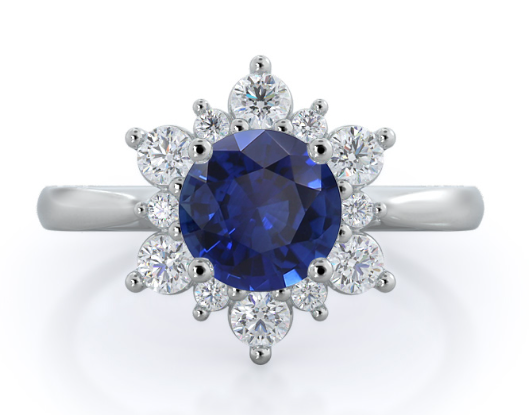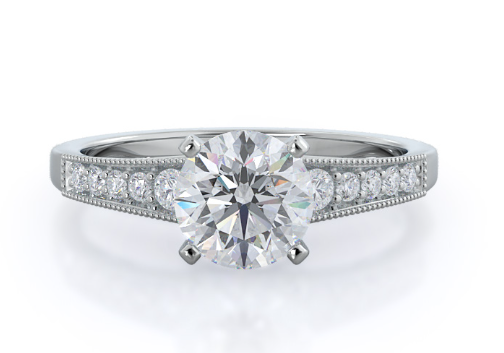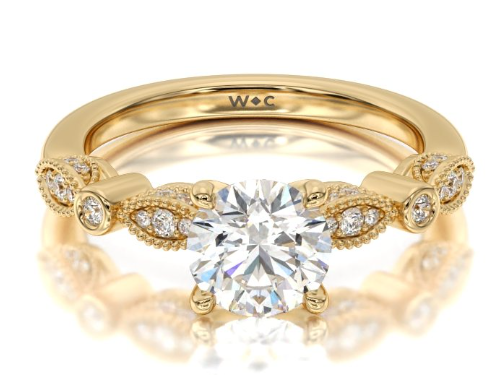Vintage Inspired Engagement Rings: What Makes Them Special?

These days, vintage-inspired engagement rings get a lot of attention. As recently as a few years ago, most couples went with a simple diamond solitaire rather than trying to get something different. However, the overall trend of not wanting the “same old thing” has carried beyond simple accessories to the world of engagement rings.
Once upon a time, many couples would recycle vintage rings passed down in their families. However, this option isn't available for many young couples today. In fact, vintage rings for women are usually something that you have to buy yourself. That isn't to say, however, that vintage diamond rings are necessarily out of your reach. In fact, you can frequently buy these from antique dealers and estate jewelry shops.
With that said, couples who love the vintage look but would rather have something brand-new can consider vintage-style engagement rings. Unlike true vintage rings, these are either replicas of old designs or something made in the style of a particular time period. They have the advantage of modern gem certifications and other perks.
TABLE OF CONTENTS
Vintage Engagement Ring Style Periods
Whether you choose to buy vintage engagement rings or select a modern replica, you should understand the popular jewelry periods and the common gemstones in each. The combination of diamonds and colored gemstones is common throughout several of these periods.
Victorian
Queen Victoria is legendary for her style during a reign that spanned over 63 years. Legendary for the devotion she had to her husband, Queen Victoria was a big fan of sapphires. For this reason, you will see a lot of vintage sapphire engagement rings from this era. Many of them also have white diamonds.

Star Halo Sapphire Ring
Perhaps the most famous feature of Victorian engagement rings is the chunky halo design. Frequently, you will see these with vintage sapphire rings, but emerald halos and even garnets are also chosen. Another common style is a cluster of diamonds or other precious stones. As with their modern counterparts, these give a bold look at a much lower price than using a big stone.
Edwardian
During the Edwardian era, you similarly see engagement rings with precious stones. For example, you might see a large diamond in a setting that features filigree or milgrain, which is set with smaller stones. There is a lot of variety here — you might see a small sapphire set in the middle of a bezel setting and surround by filigree embellishments. Frequently, you'll see several of these on each side.

Milgrain Diamond Engagement Ring
With that said, not everything is diamonds, and you'll often see colored stones take center stage. For instance, you might find a vintage emerald engagement ring in your grandmother's jewelry box. We also see plenty of vintage ruby rings from this time. Colored gems were worn in both engagement rings and other jewelry, including cocktail rings.
Finally, it's important to note that the Edwardian period moved beyond vintage gold engagement rings. In fact, this is the first. Where you see significant numbers of platinum engagement rings. The cold, white metal lends itself well to vintage aquamarine rings, both with and without diamonds.
Art Nouveau and Art Deco
Both Art Nouveau and Art Deco hail from around the same era. Generally speaking, they span from about 1920 until 1939, when war broke out in Europe. With Art Nouveau designs, you’ll be hard-pressed to find vintage emerald rings for a left-hand design — during this period, there is a heavy emphasis on diamonds. You’ll also see an emphasis on graceful, curved lines. Often, this involved a larger center diamond with smaller ones set in the design elements. Sometimes, you'll also see a bit of filigree and milgrain.

Vintage Art Deco Solitaire Ring
On the other hand, Art Deco designers loved colored stones. As with their Victorian counterparts, they love to mix diamonds with rubies, sapphires, and emeralds. But unlike other periods we’ve discussed, Art Deco features harsher lines. Therefore, you might find several diamonds set in a square shape or geometric design elements along a ring shank. And because the Art Deco period loved bright colors, you will see multiple colored stones added to the same design.
Retro Period
Finally, let's look at the Retro period. Chances are that your grandmother's ring dates from this period because it spans the 1940s through 1950. Because of the war in Europe, designers needed to be flexible about materials. Platinum was more popular, but it wasn’t always available. For this reason, white gold started gaining popularity as an acceptable substitute. You'll also find yellow gold examples from this period.

Vintage Celtic Square Knot Engagement Ring
Retro engagement rings are also very bold, strong designs. In this sense, they build on the more ornate Art Deco jewelry. However, they were more simple because of the war deprivations. Colored stones are less common for retro rings, so this isn’t the place to find vintage opal rings outside of Australia.
Precious Metal Options
No matter what time period you choose, it's important to think about what metals you prefer. In some situations, the selection makes more sense based on the overall style of your ring, or which color gems you might choose. However, you must also be careful about skin sensitivities. If you are sensitive to nickel then you don't want to pick white gold. Instead, platinum is the best choice for this and other metal sensitivities.
With that said, here are your options:
- Yellow Gold. This was the most popular choice for centuries, and you'll see it a lot in vintage engagement rings.
- Rose Gold. Developed in 19th Century Russia, this metal is late to the antique jewelry scene. However, it's a great option for vintage-inspired rings because of its feminine vibe.
- White Gold. Another later innovation, this is a great option for aquamarine and sapphire rings. It was often a substitute for platinum during the 20th-century wars. However, it's a great budget option for vintage-inspired rings.
- Platinum. As we mentioned above, platinum was very popular during the first half of the 20th Century. However, it's still an excellent choice for heirloom-quality jewelry and for people with skin allergies. You’ll also find it very durable. Your platinum engagement ring would last a lifetime.
As you can see, there are similar metal options between jewelry and antiques. However, rose gold and white gold are less common.
Engagement Ring Buying Tips
Now that you understand the different vintage engagement ring options, it's time to think about shopping. There are several tips that you can follow which will make your experience much more pleasant.
Know What you're Getting
For a genuine vintage ring, there probably isn't any certification available. However, if you are purchasing a new, vintage-inspired ring, make sure that that all stones are properly certified. Usually, this will come from the two biggest labs: the GIA, or the IGI. This is true whether you buy mind diamonds or lab-created ones. Also, make sure that any precious metals on vintage rings have been tested for purity.
Think About the Gemstones
Most colored gems are beautiful in rings. But that doesn't mean that you should settle for poor quality. Ideally, you want an ideal color saturation for each gem, which is different by type. For example, a sapphire should be neither too light nor too dark. And for an emerald ring, you are unlikely to get a high level of clarity, which is fine if you have great color.
Similarly, think about the durability of your gem. Sapphires, rubies, and emeralds are popular in vintage jewelry because they are highly durable. The same goes for aquamarines. On the other hand, a softer gem like opals and pearls won't survive well in engagement rings. Choose these stones for jewelry you'll wear occasionally.
Stay Within your Budget
One of the great things about antique jewelry is that you can get something special at a reasonable price. This is also true to an extent with modern, vintage-inspired jewelry, because of its stones. But no matter what you pick, be sure to stick to your budget. Few things are worse than having to pay off a huge bill that you can't afford, especially right before your wedding.
Choose a Reputable Brand
Finally, choose a retailer that will protect your interests. For antique jewelry, you want someone who will give you an honest price and accurately represent the ring. Buy new jewelry from a reputable jeweler that uses certified diamonds and ethically-sourced stones. Either way, make sure that they have a customer-friendly return policy. You don't want to get stuck with a ring that she won't wear, and not be able to return it.
FAQs
How is a vintage inspired ring different from a vintage ring?
Are vintage inspired engagement rings popular?
Are vintage inspired engagement rings expensive?
What makes an engagement ring Victorian?







